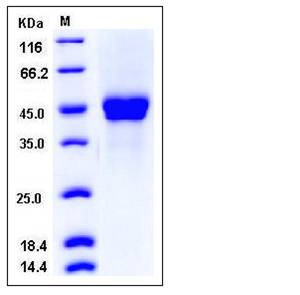Human PTX3 / Pentraxin 3 / TSG-14 Protein (His Tag)
PTX3,TNFAIP5,TSG-14
- 100ug (NPP4206) Please inquiry
| Catalog Number | P12082-H08H |
|---|---|
| Organism Species | Human |
| Host | Human Cells |
| Synonyms | PTX3,TNFAIP5,TSG-14 |
| Molecular Weight | The secreted recombinant human PTX3 consists of 375 amino acids and has a predicted molecular mass of 41.6 kDa. In SDS-PAGE under reducing conditions, the apparent molecular mass of the protein is approximately 43-47 kDa. |
| predicted N | Glu 18 |
| SDS-PAGE |  |
| Purity | > 97 % as determined by SDS-PAGE |
| Protein Construction | A DNA sequence encoding the human PTX3 (NP_002843.2) (Met 1-Ser 381) was fused with a polyhistidine tag at the C-terminus. |
| Bio-activity | |
| Research Area | Cardiovascular |Atherosclerosis |Vascular Inflammation |Inflammatory mediators |
| Formulation | Lyophilized from sterile PBS, pH 7.4 1. Normally 5 % - 8 % trehalose and mannitol are added as protectants before lyophilization. Specific concentrations are included in the hardcopy of COA. |
| Background | Pentraxin-related protein PTX3, also known as Tumor necrosis factor alpha-induced protein 5, Tumor necrosis factor-inducible gene 14 protein, TSG-14, PTX3 and TNFAIP5, is a secreted protein which contains one pentaxin domain. PTX3 plays a role in the regulation of innate resistance to pathogens, inflammatory reactions, possibly clearance of self-components and female fertility. Pentraxins are a family of evolutionarily conserved multifunctional pattern-recognition proteins characterized by a cyclic multimeric structure. Based on the primary structure of the subunit, the pentraxins are divided into two groups: short pentraxins and long pentraxins. C-reactive protein (CRP) and serum amyloid P-component (SAP) are the two short pentraxins. The prototype protein of the long pentraxin group is pentraxin 3 (PTX3). CRP and SAP are produced primarily in the liver in response to IL-6, while PTX3 is produced by a variety of tissues and cells and in particular by innate immunity cells in response to proinflammatory signals and Toll-like receptor (TLR) engagement. PTX3 is essential in female fertility by acting as a nodal point for the assembly of the cumulus oophorus hyaluronan-rich extracellular matrix. PTX3 interacts with several ligands, including growth factors, extracellular matrix components and selected pathogens, playing a role in complement activation and facilitating pathogen recognition by phagocytes, acting as a predecessor of antibodies. PTX3 may also contribute to the pathogenesis of atherosclerosis. |
| Reference |
